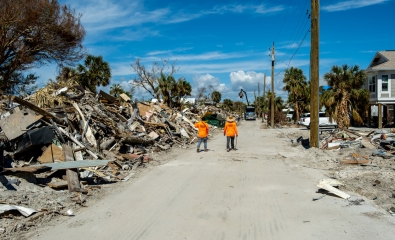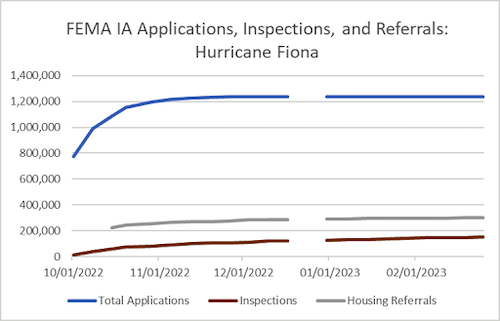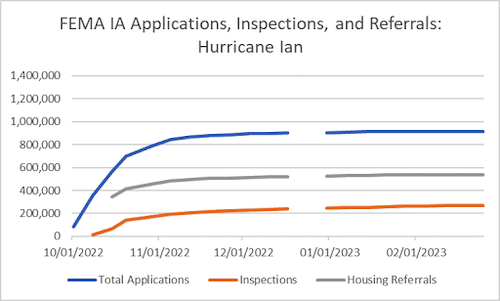
Updated: What We Learned from Monitoring Hurricanes Fiona and Ian
After the devastating storms of the 2022 hurricane season, many disaster survivors in Puerto Rico and Florida were unable to access much-needed assistance through FEMA. During our ongoing analysis of FEMA’s Individual and Households Program (IHP) assistance data1 on Hurricanes Fiona and Ian, only a small proportion of Puerto Rican applicants received Housing Assistance, and thousands of applications in both Florida and Puerto Rico were rejected for failure to verify homeownership. Housing Assistance is assistance from FEMA that can fund home repair, temporary housing, rental assistance, and other housing-related costs. Reports from our partners shed light on several reasons for these findings, including language barriers and confusion around program rules and requirements. As our previous research has noted, these issues have serious consequences for the well-being of disaster survivors and the credibility and efficacy of FEMA itself.
Many Applications, Few Inspections
Our research team monitored FEMA data from October 2022 through February 2023 to provide an up-to-date picture of FEMA applications, inspections, and housing assistance for our partners on the ground in Florida and Puerto Rico. Applicants for Housing Assistance must have a property inspection before their eligibility is determined. Despite the thousands of IHP applications submitted between October and February, only 1 in 10 applicants have made it to the inspection step of the eligibility process.
In Puerto Rico, roughly 75% of the applicants, 938,583 out of 1,239,099 were not referred for Housing Assistance. A further 13.8% (171,471) of applicants were referred for Housing Assistance but did not receive an inspection. As of February 25, 2023, only 10.4% (129,045) of applicants were referred for Housing Assistance and had an inspection, both of which are necessary to actually receive housing assistance.
In Florida, 41% of applicants, 347,827 out of 911,591, were not referred for Housing Assistance. A further 30% (274,544) of applicants were referred for Housing Assistance but did not receive an inspection. Although the number of inspections has remained low across both disaster areas, 29.6% of applicants (262,220) in Florida had received an inspection as of February 25, 2023, compared to just 10.4% in Puerto Rico.

Based on FEMA Individual Assistance Data available here. Monitoring was suspended during the December holidays.

Based on FEMA Individual Assistance Data available here. Monitoring was suspended during the December holidays.
Few eligible applicants are receiving Housing Assistance. By February 25, 2023, only 42% of applicants for FEMA IHP had been deemed eligible for FEMA assistance related to Hurricane Ian. Of those, at least 59% have received $700 — the default amount — in Critical Needs Assistance2 which does not require a home inspection — while only 18.8% have received Housing Assistance. For Hurricane Fiona, 60% of applicants have been found eligible for FEMA assistance. Of those, at least 67% have received $700 in Critical Needs Assistance while only 2.3% have received Housing Assistance. These numbers suggest that FEMA moved swiftly to address applicants’ immediate post-disaster needs like groceries, gasoline, or a hotel room but that there are serious systemic issues with the way applications for other types of disaster assistance, especially Housing Assistance, are handled.
Home Ownership Verification Remains A Barrier
In 2021, FEMA changed its program rules to allow applicants to submit multiple kinds of documents to show that they owned their homes. Despite this change, thousands of families are still being rejected for failure to prove that they own their home. As of February 25, 2023, 6.5% (19,447) of all applications related to Hurricane Fiona and 0.8% (4,688) of all applications related to Hurricane Ian had been rejected for lack of home ownership verification; alone or in combination with other factors.
Conversations with our partners at Ayuda Legal Puerto Rico have revealed that language barriers, confusion about program rules, and inconsistencies between FEMA’s written rules and what on-the-ground FEMA staff are telling applicants have been major barriers to recovery. Applicants have reported that FEMA inspectors are requiring paperwork to be notarized or a formal title, neither of which are required by FEMA. There have also been translation issues because some FEMA inspectors are not fully fluent in Spanish. Families in Puerto Rico have described being rejected for FEMA assistance without being given a reason for the denial, which makes it much harder to appeal. Applicants can and are appealing FEMA decisions, but that process is arduous and uncertain.
Four times as many applicants from Florida are receiving FEMA Housing Assistance compared to applicants from Puerto Rico. We would expect some difference in Housing Assistance rates between disasters, but the difference shown here is concerning. Although Florida had fewer overall FEMA applications than Puerto Rico, four times as many Floridians have received Housing Assistance as Puerto Ricans (71,851 to 17,155).
Delays and denials in disaster recovery have real-life consequences. Displacement can disrupt a family’s employment and education, and staying in damaged homes can lead to serious safety and health risks through exposure to mold, pests, and extreme temperatures. The challenges of navigating a confusing or unresponsive bureaucracy compounds the initial stress of disaster. Beyond the physical and psychological toll, negative experiences with disaster recovery can change how people see the government or their view of how the government sees them. It’s hard to feel like your country cares about you when you’re still waiting for assistance long after the storm that disrupted your life is out of the news cycle.
We will continue to monitor FEMA’s assistance data. You can find our methodology here.
__
Correction: A previous version of this blog, originally posted on February 14, 2023, characterized applications without a housing eligibility determination as a backlog of households awaiting FEMA inspection. Upon further review, it has become clear that these households were never referred for Housing Assistance and therefore will not receive an inspection.
1 FEMA’s Individual and Households Assistance Program (IHP) focuses on damage to individual survivors of disasters, providing direct payments to individuals or households for Housing Assistance like rental assistance and home repair, or Other Needs Assistance for disaster-related needs like medical costs, funeral costs, and transportation. FEMA can also provide Critical Needs Assistance for lifesaving and life-sustaining items, including water, food, first aid, prescriptions, infant formula, diapers, medical supplies and equipment, personal hygiene items and fuel for transportation.
2 Note: FEMA does not track the total number of applicants who receive Critical Needs Assistance, a payment of $700 to address pressing needs following a disaster. Instead, those recipients are grouped with the rest of the Other Needs Assistance recipients. We track Other Needs Assistance recipients who receive exactly $700 in aid as an estimate of who is receiving Critical Needs Assistance.